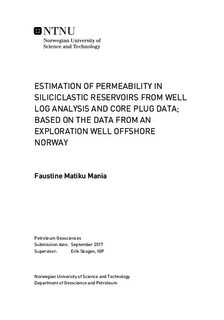| dc.description.abstract | Many approaches to estimating permeability exist. By considering the importance of rock types, various petrophysical models have been developed. This project explores techniques for applying well logs and other data to the problem of predicting permeability in uncored wells, because continuous log measurements such as NMR measure static properties of the Formation which may or may not correlate with permeability.
By finding relationships between well log measurements and permeability we can obtain continuous permeability values for the entire interval covered by well logs. These relationships are often not the same for the entire reservoir section and different correlations need to be established for each part of the reservoir. Due to the high costs of coring and laboratory analysis, permeability in most un-cored wells is estimated using correlation equations developed from limited core data. Most commonly, permeability is estimated from various well logs using either an empirical relationship, or some form of statistical regression.
The empirical models may bring wrong estimations in regions having different depositional environments if adjustments to constants and exponents in the model are not applied (Mohaghegh, Balan, & Ameri, 1997) and significant uncertainty exists in the determination of irreducible water saturation. On the other hand, statistical regression has been proposed as a more flexible solution to the problem of permeability estimation. Conventional statistical regression is generally performed parametrically using multiple, linear or nonlinear (quadratic) models that require a priori assumptions regarding functional form.
Empirical models relate porosity, permeability and irreducible water saturation. The main advantage of these methods is that unlike other methods, they do not require laboratory core analysis for permeability computations, hence can be used to wells that do not have core data and at early stages of exploration where the costs of coring are expensive.
The four empirical methods (Tixier,Timur Coates& Dumanoir and Coates) were applied to compute permeability as a function of computed porosity and water saturation and it was seen that permeability is underestimated by all empirical models because adjustments to constants was not possible and even the reservoir was not at irreducible water saturation.
On the other hand statistical regressions have been proposed to be a relative strong method in permeability prediction capability particularly multiple variable regressions. All regression methods do not have better consistency in following the actual trend in permeability; this is because of the tendency to average the entire data set to achieve reasonable values for statistical indicators. This is usually one of the weak points of all regression methods.
Conclusively it has been seen that statistical methods are better capable of predicting permeabilities in un-cored well as compared to empirical models. Empirical models requires some modifications to constants before applying them directly, though they are useful in predicting permeability trends in early stages of exploration where the cost of coring are extremely expensive. On the other hand multiple variable regression seems to be the best method in predicting permeability regardless of its few drawbacks. | |

